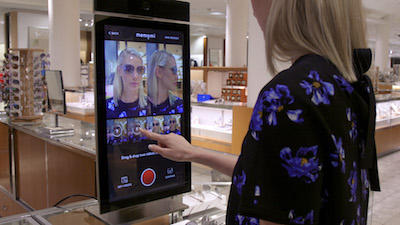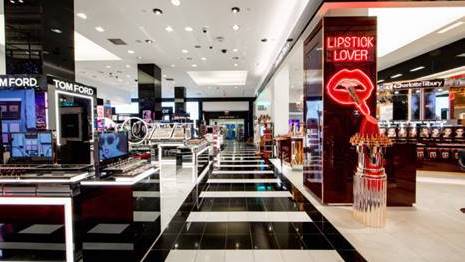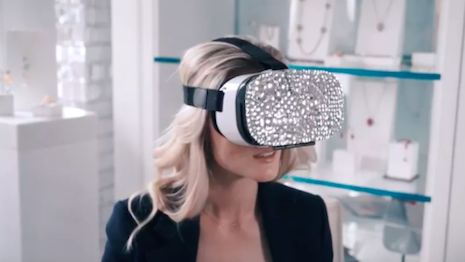As consumers seek to shop in environments that are digitally integrated, retailers are playing catch up when it comes to technology such as augmented reality and video conferencing.
According to a report from Boston Retail Partners, rather than dying out, the bricks-and-mortar store is evolving in a more digitized direction. As retailers undergo an evolution to remain competitive in the face of disruption, very few currently have the capabilities in place to offer the technology that consumers say they desire in-store.
“The gap between customers’ expectations and retailer capabilities are a result of the combination of two things: continued acceleration and elevation of consumers’ expectations and the time and cost associated with implementing new retail capabilities," said Ken Morris, principal at Boston Retail Partners. "Consumers’ expectations are shaped by the wealth of information and capabilities at their fingertips via smartphones and the experiences they encounter at every other retail interaction — online, mobile or physical.
"Retailers’ lack of agility is often restricted by legacy software that is difficult to modify for the new technologies required to support consumer expectations," he said. "There is also a disconnect between customer expectations for personalization and retailers’ capabilities.
"According to BRP’s survey, 79 percent of consumers said personalized service from a sales associate is an important factor in determining at which store they choose to shop, and 63 percent of retailers can’t identify their customers prior to checkout. If you don’t identify customers, you can't fully personalize their experience.”
Boston Retail Partners' 2019 Special Report: The Future Store is based on findings from its BRP Consumer Study and the 2019 POS/Customer Engagement Survey.
Technology plans
According to a survey conducted by BRP, 32 percent of consumers would be likely to shop in a store that has augmented reality features, and 29 percent are interested in using virtual reality in store.
However, only 9 percent of retailers currently have AR and 7 percent offer VR experiences. Retailers are on track to better align their capabilities with consumer requests in three years, when an additional 29 percent plan to have AR in place and 23 percent plan to roll out VR.
Consumers are also interested in virtual mirrors, with 36 percent showing a desire to be able to virtually try on items. Currently only 9 percent of retailers have digital mirrors in stores.
Some luxury brands are ahead of the curve. For instance, Neiman Marcus rolled out virtual mirrors in its fashion, eyewear and beauty departments.

Neiman Marcus' virtual mirror. Image credit: Neiman Marcus
One area where retailers have already invested is video conferencing. One in five retailers give consumers the opportunity to talk to store associates from their home, a feature that 27 percent of consumers seek.
When LVMH’s 24 Sèvres ecommerce platform launched in 2017, the retailer gave consumers the opportunity to video chat with stylists, bringing the Parisian shopping experience to a global audience (see story).
Meanwhile, John Hardy has partnered with ecommerce mobile application Hero, which allows online shoppers to connect with sales associates who are physically at the store with a combination of messaging, augmented reality and video (see story).

John Hardy is among the retailers using Hero. Image courtesy of Hero
Along with experiences that connect clients with human help, consumers are interested in do-it-yourself retail. About half want a store that has self-checkout, while 57 percent are interested in automated returns.
However, automation is less likely to be implemented by luxury brands, where high-touch service is still dominant. While robots can perform some tasks, they cannot replace the nuanced interactions between humans.
As well as offering a service to consumers, technology can give retailers the ability to better know their shoppers.
About three-quarters of retailers plan to have the capability for emailed receipts in the next three years. Sending emailed receipts not only gives consumers a proof of purchase they will not worry about losing, but allows retailers the chance to connect a shopper’s purchase with their contact details for retargeting and suggested selling.
Fifty-five percent of retailers plan to have implemented the Internet of Things in the next three years. Through smart, Internet-connected devices, retailers can collect data and change the store experience, including making it more personalized.
"Consumers expect a personalized, secure, channel-agnostic experience in real-time," BRP's Mr. Morris said. "Stores must now encompass both the digital and physical worlds as customers expect a personalized experience in any channel.
"Customers, especially millennials and Gen Z, want the sensory experience generally available in the physical world, such as touching and feeling merchandise and personally interacting with a knowledgeable associate, married with the unique and personalized shopping experience common in the digital world."
Personalization and performance
What will differentiate retailers in the future will be personalization and the added value of high-tech experiences, rather than what merchandise is on the sales floor.
Department store chain Bloomingdale’s is capitalizing on the growing popularity of high-end cosmetics by unveiling a new beauty floor at its New York flagship.
The retailer has been undergoing an expansive renovation to maintain its position as a shopping destination in the ecommerce age. The refreshed beauty department has spa rooms, a fragrance hall, interactive displays and other services meant to entice in-store shoppers.

A new beauty floor is the latest addition to the revamped Bloomingdale's flagship. Image courtesy of Bloomingdale's
For instance, Estée Lauder’s shop features YouCam technology for virtual lipstick try-ons and an iMatch color-matching service to help consumers find the best shades of foundation, blush and more (see story).
For luxury brands, technology is often used to enhance rather than replace the human element of retail.
For example, Balmain's Via Montenapoleone flagship in Milan included a virtual reality storytelling experience.
Following the Milan boutique’s opening, the brand set up a temporary lounge. Here, consumers could put on a specially designed Oculus headset to take a virtual tour of Paris guided by Mr. Rousteing. “My City of Lights” follows the designer’s emotional journey as he creates each runway collection, taking consumers into the process (see story).
Technology is impacting retail beyond the physical store.
As innovations such as augmented reality and voice assistants become more mainstream, consumers are expected to move even more of their shopping online.
The majority of consumers who have shopped online using augmented reality would be willing to give up the apparel in-store buying experience entirely, according to a report from Adtaxi. While the luxury buying process is largely still driven by physical stores, technology could make more consumers willing to forego the bricks-and-mortar experience in the coming years (see story).
“Consumers love the theater of shopping, which is why we are seeing many pure-play online retailers starting to open brick-and-mortar stores and store concepts continue to change," Mr. Morris said. "The in-store experience is paramount for apparel and other products that consumers want to touch, feel, demo or try on.
"Customers want a multi-dimensional or multi-sense shopping experience," he said. "Retail is theater and with technologies like AR and VR, the retail store is no longer the only stage where the theater of retail can take place.
"New technology will further empower customers as they can dictate their own personal stage and experience.”
{"ct":"dwCBDQe27+hym5v7BX6mKMuus20I6i6DroZ8FjvQfji\/nJKSyd7lx\/7cKNsmdgQpAeYfHY1OCSQmDHVm7sUy\/aNXGaG80kkPdhwb2zf1jbRLHzoDLfwgYlXcirSd\/BvQlQmP68M7aatB1WXtpEkTwVwfETzj+20qC16CtNQkIHbTgO5kZSyejds8oDEIofNy\/ij5eFYt8Ip2ED\/NaJtjm+ZD5LzPysTZCWA5BYDo+35pvL7t6qkeFLcS11M\/kNVLEWSmHzQv7ykje3OBXAXeA3jV3xI5uTRmXrnJntcnx1tZDU20hvNRSquo9G5ZP8R025detFd+L72h2cZkvUf3BaCAlj24ni3eFWxbYqjvx3pjl9Jy9FHQw\/1aO0fFtgWcAru7tKroz2Azibv88lkU9jBvYlXtM0HReiNKdMPGAAfPYraqHPykkiTouVEkFG\/PQ6WfnN4snrSAh6eEPrRxECaLVuXnbUnWEMMPdApPkVFJp1kgb0O4g0ivm8Eb1p+uldY6qhftBE4mgWbHCDPPreNyfwValYJ7deEYdEqQ0hYjHGPLakM6ubY90ICOYxqNauHl75vmgN7IAkc89ad4Jgmkii50tPDpG+de6R9Di1t5Ba03+KP5SsGtmLpAXh2PyBd\/adDDzdjC3klfcg460x9+x1kjQRmHhvRi557\/SD0AmlJjO8BucHh0r2JiCCCzSE+5yc3Z5O\/2rLaBl9IgnEt8gbtfURGqRxUHgTaLExjfe8xk697va8Yq5fKzCM19NmX3tYC\/8SWnL0FYG0DeAR2+Jvv+ZEnv799ecrrHNEiSxhnBnWGAzXIfi+oyInwepJBjM\/6ToJQxvIaASCgVyjplDXtVPdECJ9iSkkT2jysLRhILnfj554HVPNfhjaPXmGKF0eTJd4tB+MAUP\/dPicOLIOB0dCac9KVXSlHIx7JlcT8R5VljjtTR5hzPxXU4xQwlT6mzGjCOCNs5eldsB5XRsgLCBoIOT4cDsaL4FPWGUx4EcXJ8ZlLdF+g46\/7VzJDNvqRua4R10EOXuqQMollqnREzDNdphd5iKvItmT4pyz4sZJVLC\/oSBJYfHm38COe1qiLpkCf8yG0w48Sny2QZPCMXZ54xaDf+l6jHOFS9BMzRmjICVQZ8K3fEE4SifGKiOWXwEbTFqYnaQGRjTcqKTYZyC7OEg2VeaVzZGCSjOqRpMPOwqqmenAlgSjHDXx0weIII7U37Oila98ZzJgpsO1j4RFvwPXiyz6Hw8LWM4m5HRGlMUr+QcH7rAty3DqGMomArH0iLA1EwZQMPPNbPpnvZDclXlseHfmV9V+3LzUTc5acfh7KkIpWs6d1sWMRcgJ0\/TJ+gpdiOZXvS\/uo6t7udHszV42hbDroLsImlt+2IhWIY3hguoz9U77DFarzr7QhGzfknATTuKW0ggJ7heuiiMLqpt+iQCM7R8l98rvpcJ5\/1pNoDCQjstCdWXczdK2J6+JKIgQ0DG8ICUdsDAO7sudgQ\/YBjDKU7EQw8XSdVcc4hdBjah1HfMDrwWlkmDzdiZ3ZQJTMyuuRSQIcrsq383mbWeK6Gxbha7NEx4cq3yoRisW5XaAwcbWt\/R+qcVAiHbbT9AHBrDzmAHCXMNulMrTMp6hghhOTF5I9iKnR4lZ47ha0bGf6qWdjr5wRMCspV+F6p+9PdKzdS8BpRngNtD\/vI+bhNxtAeiY0e9L5QIwZzk9js0jpUTQdPBPTMrMD09m\/GrjBuO38PfcyZKe6jNyq8IK510kVs5mCEx9PYIRDCvEeXhCxL7N802UtogYgcOL4r64KKOii7L6+jwgz0276rzOTmRyNo8a8fXYFVpbNzqkh9+ll7Ruf78VDKqwXKPT25WXNvnGEbvr0xDb7CuqXveTMnL\/mW8IhZ1oueMgRR3EiArz0afU7UDHciZgXu2SeQKTZiq6Ev6Av9YKmuF6Ye+5kIZ4pSpzpWMS9O0piLnqqYbtZx7wJ0D+oWZRvh6HeTWIPXSpQmq3Gd9dlAhoMDRENgQQYM0a9ATqn\/klG\/HTSa0CuKbOeP9dytcxNFMt62QIzBUiUH73h9TKZWENBw0fo3F192zc+hc3o0xDi2FMt24L+hCp8vB6tqAuYCFH67jjdnixaHGk1lsCNmR5EDyvvIVDihkP+3RUj1ofrJgpIQg\/UMflM36Mj59HmKjSjwflXVKoEaAPIOqrLy2jP07dNKaL8LvGXeuYsloOHI13+l8Bqbz+s+EQT6aRYKTjJewm4YVqn2+2OCG\/WpAd61+1sCaomsC+2ENxFPJ9cNs+WIvPdf11l63NOJNCzAL6Q8X4ujrUeZC5ao4+uxEo6LIyOzkUlgtNVrIUDx16Z9csvv6YlTI76NG4+ncZxFM2UPldV71Xglzo2waCH311685C+0Pw0eRXbzwkLtRQktZNGI4j6kP6KcJXM2vevEFmreScsPwCpvTp1UBdIsVG78Vwu6V18IoNkwnM4PVEz1xmaV1i17nD9dPGqh5MtOWxXf4MO0lzTwn4JiCQuIbNj7EZ74uv7+gE537w3rf8IXqrJf6VWJPtQFXfeoBFaK64B5LQd31kQQJ5tlU1+NuQM2iHx9NTybeTwbbjr5InH4vnGYB4m+fK8Jl+oiv4Dtar9gZoIQIwG6l60takMtF1dNhsM8eH3gTD8kCUpb9\/Dwp1RZGuiaK6b+5AmWAXBiLtkEt5n3bpCaJaKX6g4ur8WXifnerT5zH4qXENIxBq355cVTMOr2gZ6PLtfkKGohaYkpEILCa2XKh0II5mSK+gutId\/8nLgVv9PtCz2d3KUMJzR9tct4SizMm8OAR+a8PEeKiscXK4exqZNjphR9GOOInlfesQzvuAdzhGxdi6ujb6wA404C64m9gSkY3Snf+IgwgbIB2hxX2w66TBQT2RqhWuQAbMYkcd75tx5oCjj2BIdv5R7frWwmsbM+ei6bmyL05MNmLIBwjgvE8w64Duk+ME+VKw5ChzRDgIZqXGOqJPXiTa0D6KhlunN57NF7e5tA57UAE9N6owzU+2Vf49WYjEbqkEi\/DT7RK28AZOjQAtD8KF\/Kwz5kQMBApdk3uanEQXyzbHquYRZ0vPh2jFN3H6Ov3tkR7QC9XmpgqM4PSttuFVqEWosy5n1SKB5Qu\/uCxyen9S3iORZPRbWkb6i6yCI+XUoRaHnPxyUFRDMPivF3UpoBznTqBHsGJ\/qVwzB6GvfT8YmcbGcGY5fkuZ1wWWr2LkJ+pEnEsNvoQL2JfJrdTE0IsPk8KDQbYTsy9HtuAR9T1qHRm7xRYv+SsM34n2D0\/YNelU86HZFWS949BN2Hag9KeKLf65i\/QfIjt0QekP7eX7NKOEf3rCI5u6FoaJwXCfTV4yJGM9QVB9RqhtBXLO4e93UkMZd+ykjuuTiufVqEoOc+ePW0lzYREKyw\/eyvp92sSKou\/NID+h2Wg9o8RSVlE9nHtwpsIm3ph03Vhn3ZLvzsm2Ay+HK4fLvcLEg2d35KcuuH1K6utrLVLnotNQat+dK9h2aFfka7kIyaKgpD89lT1xB1re7jt3AueOwLKE+3sB+MXJD7DrBtLO\/0emgaGyPUCUazERG4EVH3qPp6AEFQZUYIW6XSK\/EO3FWfw1Tsh6Nxt2\/7RuOurXH9\/uJ6XF2xPizwAeMQ+gMkG3HMk7UzlDfnNhNfKxfoZKmnq78vJy8eJiPbrF68mTTVzicNgCNNiYLT8mLC8qTZCeJkqm7uLYhEPelyJJenh0uj1n3lOQ3jLBK1VqEKuuS20mjsw+yysl4+8pg4BwxtXA0sjRDpldh0PjK4+KASw7wJN1+NY73Uj8zrJfmrtuOfe0JpgwgVgw8qUluHzriE8i4JiOXmnghoAa7mPEu1gpowkaNX8xcF1cnk967WfwxdgAbHmYRiYiZkiibsW3GrgbT66HholHN2b0Lhey+P2o5Iw4efcsyt48CYlhxk+fMU8gnUnN3jbmjC6EWIBXcBvmSYj6QgYdqPwJqt3zb\/pvHEOmuEGjLcglZGtPBxi7qerJ7y2hHyf1yt8UEqcYmK7joTnVFLDmyjNOZu\/xAB7+b\/gDEOrGZlhsaohHh8ZKV+j31FulfnBNlvdEJAHcyW2JC+gZqimpL2MMbt4uEXwFq3bg9i2nuAUvg88w+9iZ59SQeCwB8W3Cb8aMFvk9jpTRj+WpD9jThdKqDacqDESNW\/Suz0rlwVR8jE+UGXkt+EfnkRSuY0a2izyaTqaNCvreVaZEW0jvd3sQMoeCjh9wIEMvuUGTN6TUL48jCZ0xkMftjBwA02WREHKzsAPOlr7C5yJSG5rzLXxT9mCrssVhuTimU\/m9lmA8flxj5P0Q+6aGQkK0r3Xo5+0DnrWqh+\/HvVNAjs0GGjc2X4YqX9k43ijGCG0J0MkZdYDSxdMy5j9bHfdtCZancPAJCsdR\/9wfC8Cm3mQmEpXxjSKypXw4oYGXFkwR2h2VJPxe1+5Lb6RnCO1tVyEIZSx\/U4pUnt2gqiTdcthiO9zc1e83\/7pfb4f6V+yA3UeH14gIQQxAESP6Q+slxu2qNvoFNDp1Ize+d6EuT9cE9YiRKCjGkz1hwyQRGiQqSnYrgostcH+OEFYnm6uNO5GJ60cwP53SzkhXpWSyfa40LdCY77122TmOIkCDqoE7mCnzCvcbHQj9G79OZCbugydnoIBhTaTLCo3Ewdb8rrl\/ruYwWvSqc9HP2wZ8U0M8TIHnOntenjiyoECxBnHjoi9eluOsgMvcNcv7FdjecRvR1RBR7Y0n\/4fORcElGe3uuAIfFeDw3J9g4lpyaODtRAcPLl3OqMzZaxh86a7XKVk\/Z4jz9glOOA9GHd+KD7GfMRKcfay+\/dIFVCBpwFkX6SGQrKx0UWmvwthV0KtRjWcnvOClADCdOtLvwW\/STR2PqbgQB9i8Ln4bI+NdfqNURmdqgS9\/iMqVY0E+x+ztO\/adGYmJ9kDgRgvNgt5vUXfQqsSyUy2ugXQGUh+\/7cZUcvH7SAdtmMvVisM0de2QIgHTzc2HUE\/40l4SFL9ZRWv4e5ke1Y9CSk5IkrQ7Kopd9D82KiPomo1ktcJ9RBbzoeGX6E435Fzq+1ZCiaVhtAHqyphGpwCdKXEZyXRC8yTqxpvo3RGmFnhGbud7SZ51iI\/XGfGKP36iz5end64lwUD2Snz07MNizpAMqyMbwl5VqjurFN\/GVA7y02YXqr2\/3UsYgKwNj7J6HYS7IRQX+ojq2gX\/eYm61Dr3qwU0NNXVcIO33SBMd5CXHzW3Ep+NNWqaEhfYwYdvZOiZheDQ0JzxoTYidRYuFwOvALqQCMBoDbfH7uGcDZrICZIszme390IkBfakhtnMxXwpvQP6Aer5SvcpnNWoIecuOvWYQN5Alu62O01jdvR98n4U6BskccUQtBr\/Tjm+BbDX2tghN2VKmybaLaASmAWNL7I2sMMYMHuiW1uk73cYC1RPSS36+ae8Elz9kSAaTRyXzZgxcRsldqg4Cx6fsBa+mI+\/Cm4lo2EugsBIh8Amu8zmVWrngyGonitwTWIzJMysN11h+XrggNCZ550\/Uv3w43nhfxUUvThTIg\/1D0K6QOvNFAniu1Pd+UzeBTgsPs2Cf+nSiN1Hy53cjMnxJehLv0+m7+EnpVw\/AKFbn9fVmOH+Qe+aOaA9T1bUlh+fSkmK5Yr6Bc5elwvvdDnhK90Laz+6n0aCdzBqaTyXfwqkJpHQLWjiyAiordpm2TthdPlSc6awuAfy+U7XIx9po+1XTKL2g3OGuWBLWEFf0OERrW14BKXLf2FCiNP4xldoGYFQW7eZ+e9kTsp4Fb0lzuFiHX9FyfqxAXw72CBWP5hyZH21qMyV57vEUqZLF24rqKmJuuU0O6Z4O+beYm2WuXMcGa+ANCyHJqk2nzhlnXS3WH3WViuzoI90ehJzEzz\/QvWeSWaiqV1Ox7JiKmSbsh04CGXkPLGrEXlmmNgnNh+e\/dLm6G+h\/WaBMNXWw6fNPQcKOqQKeZz1UID88kv28j6MA9vDCKmbBAQr5NVs0Rlx0q+dRbB+JdaajSHxfYfvxZBJpuTy14y4qzDaiC\/AY\/TqGudc5yFTFe5DgySUbbaCJJOCeJ388\/CeappqFpb34Req0CoWugdYhNlvBfE8BECUzugT+Ejq7ZHyK16TTdgF0gAHfTv+9FRyTvV3v35tY9DVswKf3yB3S\/hdqRQhllsfxMUyB8B4mypqpQfp61+IzwNYCbJa\/b\/+nxiJ19UMTNlpqPxUQj306HSoQ+IV7X6YpArJjOls7D89RoPGLvs3jwS5OhS790a+W9tdpUnoj7OQnrs\/nsjC05H+ytteAhT7ZNHBZaoLzlCWY952ielMRzZkCnyDZWlhtxzmOgS\/DCXbexLDpewrD5eotEf4FyUTCJ5V1eeUSlt3ycFSFRekcAP7elrf5LwfIyz+w4dFAyy3702bFSusXXsqhgciZQmCzOm631DNohYMLAa7+xV2LYUf80eFdRnCYNlibXYxK9BVJ5ww8HMowbg5BKQwNbWkQxEqLmVxCmGsxEvreBmcsahCUuXldokOoEE9nKSfWMiIl7FP5FmU08zudac7a8+dMB+VVv0OWuOvBApApfAREQSmSyK6HsFJ0ieTKu+gazfkER4CYayQ0GK+zr\/E3lgPpvv+W8f6vD+R3GvlCNkfOD72RnIb0W+G2GkC50YkuYzcg7hcd5nGWD+pPXy9zM6lJqG5tLPEmLmQg4Bu\/W0mo2BBNQhjj3WvB8ZpahVEk29iq8TCctHZPldtb2VlpuBn2jsSSQZAI+DpdWXYSXwL+9rknwAcCPI\/FHPyxVg401vhlwpGgGIUnpuX8LORsjosYNeZoNRas1HWoSYmSFFpA\/KHfICiknM0qqTtBtRij9axmh6hNC1tGgC6CYZFoeTrg5I8Qgv\/sDfl1G9nkGXtSu0+oWW0fDrYrL9MGc4ieUgxDERhG9qizVWG+JzVBULynBRE+u0YGJQEmxQJR6+TMKeb2WWn6vmFewe5I7LKVGLtUbkHJgzxTYHaOdfAJwAUgzNgDdiXAIArLjQAKvBpHdkfmBLgrGNqWNOXL7FQQWrgM19K9OxsZ2\/F4gSMoNHfdbarpGkW1lmIlas0x6zqTp\/d5e9mmsUFnk7RIm80dA9wwsQfUg+suBj2nbdpXeAA0Og0Hp9yes0xUtEOlIPnyyrskYVXukuB4VSiJM6Rw3ENFHhWPKnTLMbL8YYrabRpsVtJMsYtUWCL\/Rfzghr4hw1TGNI8PaCxppQFHVs2W6iiIRKB5TKxOv4wOgCQGCotVvMpiGiRMpMe+KhxPGy9gVVzoIN2x4S8wiESX1qiv4Rr9cS4iQz3bkXk1GKNY6P775vgtqflTumAi2TUa6bpxdAp4dXhQ5M4fAGRgJo2r7Be5mgm2CE8TL\/ycE\/Ua1o4BBraDYKhz9\/hz+7NsHojNw45Wj2EjgbdEftQC5l\/71avzgmW4J04hLymnZFayF7AfRU4Tit3LnWEA1USIc32jseIK2ttsCmOFMDAQbbcz6wJN9XJJLimaJGC7\/vIgtICAbjsayjchJc\/adnXlGDytesWBw1pyU9s4BjwjobAWN1XGhaFHEUMD5x75jzjfS\/5+W5z+aNwYX5E4XhT7zxjMylmnH+DxGQmV6ihsaiVeKFU8o9EcmcJlI80sFSwHwfY1WEcCRkuMJawRqo6uUGatmoGHz9iZPwiW7LQW7TM8+iyYlN6XjPgXzGGLM7CbRx1u1uwiOmRqVMzJccqUtLwF9Hiv2jesxxXs72rK8H\/TSJs2tuNzggm3e+Xha5oUf8VSn\/Rj5\/EKxAqPrQ6wMX\/KPdov92\/1SCsfubRRL6k3NNu2xA2lqueO6LPapD+UIx0sQ+MjMJD+tLRMx98+L0xVzzLUBECKlBwlCh4SU\/0m+QI5b4NEXqqAH9gfWX7AacCtWBlTB00B+AN\/YwpNPLyvN+3pPMt19EuAW\/EPcEzD9O+3RTntkihYFuF9E1Z2xFA2vvxCYnsXz6rI\/iAbmcqtUEj5ql4cjS3ldyfL7VWBBa+DmMCGy5xtYkBmSmyesWfhAwqGOv9MNcnJYLyAN3CFePep3kRMbfm2YztKWyV5aVscJilWiaQgSy5+yRJKWUQVt\/x7tkJolfJB8ZqBfzS4ILr4T5zlHMrskTbn7amOz2BtBdICOaDP2VLd+93mn1Z82J61IWNccl+4b3H1qgcRoiYNLx4vKscefBvZxft7bI8qG\/pkmPik90Ekn48ebzCHmlvJh5S8UkvpMqURQfvR24\/PcR+oRyKwGC3VwIu\/vHKbZIfsC044P8De+GHh8qkPRqbgaZ+ZD4UocS1Llm\/yjQ\/0HhbCICyPuXyOtgdSldsDGLvF4R9nMl86QWbMtVH3flu6pmmDKF+XNxjfnS82q5zpOqpnIrJ6DYGW1x1epGdFtE4ppcjwPbHYOclV8gErFSScAJXa\/FRO89Q71tA+wJUFpqxGcG5AJLghXVzbOwi+MmlSqrmbaORUv\/exDdCnrLiw6UdLO8AQW21g4KR7NY9AwU2hMhtzZ0aua+kCcgHRAp2Vzh6LAaGUJ5oI2LCeDha4iW+WxjUU9V0CCiaSPe8r4ZkAUo95QbtgCB1zhGBPOjF7hZkC5McYkfjZLES6sbWaSh5bRIDW2VV19gxYosoF5votvTmCSA\/8VdYqdAsBHs5kYkp0iBTh+YVcXNEpW6VtE2d5WuhDR8MFslOwQZBWfuchh2uu\/raNjKzB+dPVbSayYVd4JO9SqibindHl+T2S4IwILmqJ7ow3wmtr8taVLmRZyCNatcqaF88pl2kT7nwwWvYFKev626O6x7qyPwQW57OMxos07+ShHDlZftOoXfmYD+F5+ogQJojdz7Tj3ew0XMVG\/e894aaOa2hWgfYAOc9DoZTJWAon2BQX5ODwG4UUQ1Eh+hplVYxyns1UGOZNRuSQu39bZ6afyaYT1hhtBP8u+h8I+nlCUkcTWDyDyzy0gc22RP39dgUS+jFAYsK4qfxKsVuTXOorvDXc9LmMcixMF0ezHH0Ly3UTquindR8JTgJOhjYX+QhIUZZM+LqlOWR1pECWYz6ky1jFntwjo0fZ98DhB2\/QQCfu46f6MmTtvHZqi7Hel+6t4M5vR7rP6M5DXCRDEBvjRMSo50+\/Agj1anKUkxhRjM5PhrP1ebJ9ICbpojce2w+ornl7j2cWUs13\/S3PvU94Ym7XQzskN8MNfZwGGvTm05qxLQk\/lA+8B8+T\/JpoT97c+4JR6BshLDBkX4SaS44LPb0yRDRpCcCTY+MA+NWu4umt0q3N985pQtrsYTBcW6RmLqv2MheiyD\/EW8ukINPZFDbu2wgn0smVvczGzr5ylyfmoOzG6UGeB7kR35BYNywNbSii5sYhFdCIGrwzEiAXr12dMnD63u2Agv3yHb2TauQ2e7yy3jT0lsD1t9EBk3Q2pdqbfl+TvdZd8tZJEqfv7CJ8InkAyhXW5Th5YRpfqnPm11Ha\/mZDdLVuUBt+\/fHjtgddkvSFRSAgxuXirW3x2GocsaYb95HP73dnMOOw90jcAB1dYHo+2+sCe5NmoANIu45ywcbsPTkne\/S2rEmbkBSPjkHi7yV3fDOrF8gMpTEo6QJhMrVyukJ\/+ouRwflRue9DcUVownTcnEzWeD4aDfXh3LoLV1kE+bDijJnxr1cus\/GCxRYiJSt9fr6YkzdmKKBE4JgJ4bGrVzTQ5y+vlfyohLij15jG0Lcu9mM3pdHbxSWSJeTWxkjmtXbM438lkCQXyAS9hpi+rl8PDSZRdxh\/Mvbuses1j61+zkKZvDA9Ca6HI8g6hVttdCmpnkEMxE9l\/RxZCKLDzQhycpFyzKML7U04fzNDkycktBeK09s27e5IwXZooS\/dxdBKPKElMv\/KoQuZZY5yrkuOusIAHYctW\/0Fi7EmRECH59DsAQvxdAt20MO9rPbx+MX7zYFSSToT+rLcKAlW96HWB2QlYusLUjiT2o\/7yojJxvzvpjlyNQa1aZPfkUAk98qXkARBwudTEoKsRFnLD6yZ+yZc\/h3q4N6bFHmXbMuz813kCeRSuFHudfhCTnKGqfrJAZsYxnLjQOo122NolLZsjprecd3FyZWiI2fF46u3pPrXfU9Uf5Xg\/UAFGmknpCDKEb9aS\/XEBk3nsRMyGeipoJUS8IzVcnepFbgj4PfNewLPNUmyOHAnO5y+9kULhA2hkcnodPmc8ur+Yg\/yvmc7ttaNE3xe32NJicxU15QC1GqFkRDHmPkPTNGtGbLyjOsPJCJ2nyPp3B39IYPsdytffJtqPX\/TS7KEJuzH0YCJD0L1SqFduRKaJfrddXLVaefE03Z50X6reMpXrxY2zU6Y1jmf74Gz9yqyFrKpGaiN\/yFm7U90Z+J59VulS5AtlEaXLNMSeDdw+lcfgnCDlEs79MhG\/Tcg\/cLYRuV2z+69o0qd4pSkkCisP3f9lNBdrzlc8qvS1CI0aPiaW2pzpg7STA4SCpAuaWR4bKv8bQ04BqhXKZ+o3gI00M0rnWVhesy5bYp+iV3FDboE1FLtq2zNPtn66sWVvWytl8qivRAzGrba\/WZqzaqgZCrQ3nb6gPUBONQxm1n6GSrbME8RgFMGw\/LWjmV\/vvcn7\/fVW9iaA9dIZGLma7UZrml+qQP3xuean+Ae5u1H3sqpFGI8H8YmAnGBZ1IeIDe91+sbkLffaoCQi16mqAcjTmYGCa9qBX33M0a\/trv1fjdE+vUx1F2bf8tVa41Jj3XTab87Y+HgapaV7oy+QxPH2KWOwyoVbTYQi3LKljiF+Pss51OjyaYPWk4N\/NgFC49\/clob89y8ysKzI3EW1rtc1zq2f6CvyHEhCOYLLFmtGd02Vy7ymH0a\/F2DG1X3OCfLJcMg4aNSp7\/r74vafJjJ8mB\/JfAZrz0ph3q4TXn\/rgSr\/OqI8Mam7ntm8zjpMncLTC6BQ070vT4+5EC9srdJ5\/orPJ6VB7khSUZ+C8irOlJpZDodrAquF5NpNVQz4atvLUdSmuNzd5Lnx47AgosV4rGppn+9txMAI2soem3d\/5swUdI7jzOIm8a\/vI1Nx8\/dTatnfZT4rwmYDLohHWBVbRkiorGqKFXOVIMzPtwxa0jGLAkMJ60A07ahWlg+hLnvm7N49OwmRH+to+JT5jrolLW1iJpemyck9CozO7qmoKEcZ1Hyq\/OofpPLiC83ndm8egAs1+LM0He0Z7v62faCbJVp4zOljh5x0lYG2rLR4xX705zsSTNJy1pn9njG5SJCeT1dKrY3lh34qAqMRmkoLtyDJJQoKdCFqqcwmpgsjwb1YxYWXK1\/IrTT0dJWGPRAWdleQ376w0x7awIADvtGy+ieXnAepEuOqs4r\/oBqEZ4BkivXIHegwTbgVgw2pQEGHzv3Kk5M+r4Jm7AjZxWmfzoLNiG4irGSAIA2boe7NI21j03\/+shz\/IVdjH4s7GPjVEbbR31WFsx0C6wTLfCTkhf3CAR321EjPXBwAgL57qJBJgvzaDDsgk\/BuLG+zGx8ejOpF\/rjmHmKAQMG5nQEPL2ByjkGk2C4pGtTq5X\/rVvUdNKmWXYL\/0o3\/ca\/M4ZqG6UYFuJoL9wV2Hb64UjWoK0zjnL4o+oTtyvSIdQeP+I\/ybNvTf1WaanLnOCaPDbjnKzKwOUta0MnypawrRD+dUjQHcjklPicUkP6LNlS4WJxnfM0+dPQZxHDel5DXiVuF4PublO4K2oeS4X80cCu3QteERlRPQy83m+zZiqZICjniS78k+IBWWcV3Prc4tUIRQilH2RAo+VKZuMqfBZveaiqv9BXEbviLBo4XycM0BMEiJVJOKcr\/eMv8jDxzCIaBKTl8Wm+hg0VC8BSp2Lole3Ub6+\/dE6Ou6PlRoR8rqo+segpxVynb\/BRdZFzvqfheqio2ZQkpWEegWhAgRuHhkbflvlSdBzNJb1kAEmoaoyw1u3dd\/eyE5OVKOwivQfgSGlmADjb2QEGsiTidUKVbX3x\/dnLVOmbMYYYkVbEIHgJFCQEWGgn0uShKl6nA+1yhkGDG0jeySSuICk7XnqsuPBFVVNIBwkoggG\/DRQdH3NqyM5HLhvU\/TCCQSNXkWgeHEqzIz\/bZuMvuvvU3bU49Epd1U7uDsSfSdKIrqJPITnfklMfh+0P7d\/uGpROkCSoU5nCZJMjIVKnG1TmvvId5rNKPIybups23ntT7LnsUHoK\/EvmgLpFuyKyzl\/mxIbF0YDKACVS5GvWw\/O\/l+MaOApgDjQSpf\/O9knXZBHpo1Br\/o7STB8+pSJgYQ70jjOz8JzvwxvID0SxXckxq1rPo9lPZrKeqIxy62ynvvoxh4CFUJYJCEa8lv1mZrY+I1Rp8FIIyedtdZ6KSkzbCEJjmPpFyePUH7YNWzrhuPeg7njKMHi4Z7es7Wx841QMKvfhTacIZVHSr1YPqo2zSP4gHm4Q4IJ0uRdkRKM09XmkAP+molT3jw5pkHIzTf0EuH3TRyX9AzQ23YQEoAwHqfMPJv4o57Jd0rcDo97ytS2W+9mUD\/ZyqPeH2vF7TcBzQmjQWCAy5TuUFMB+Sd4IqiqGcXO+g7IVVE6Ix3h\/EEZqIlF7Efxk0K76AYUm\/B9VLSvoOmVehftnAi\/8ffnpMxa2tXtREPdiL3ZIh2TwnvNB8cobiXycC7Hz0QqytD1gYevDkuWl+cgXuj9wR1fCvnzmmxQ1uJgW44MM9kxes\/rrwiP\/l22688qrfA2cISAs7yM8KkvKxWFfsgiLudZRZffV5oWxcMQ80RnFKvBecdrk0+bxy0GKu7Q02cL2o5byJzgmSCMpq6IM\/5OspOZzGE6NysHG8oeIjKlggb8IyLP5I42gwnr7d2pTf77FbPqWP6smSp8y38i+Od65V6FuJQQwdXr76jvKVlHoBxE9550U9SU1\/YppB\/Y1PfRQ13JJ4IKnX3U+HR7V8wRMjemIUYOyTXaGCnK\/w0sCRkMIS06kjxmLhYwkuKj+PhxNAYUySTZAJa+01YhYSrI\/HaXTLZ\/BRBdgFO1tmblubOXJpmAdBYduC6PSoZkuY5gxzg1k2JBsgh4+KlBogBMZPNIcCM+ZH8bxp4NOsUJfi+fXAYnRoZYKpQ90SjISZ0CbI4MsXc3IOm0GkJIgE+4ihPVvYJAUJdCVOabkNc3EnqMjNjGmvxATt4QR8c63WumWSEyCo89K\/fggne64Ec7EzCPUX2yxaE39Vv7vLmb95Fh67ZwhAfmlT02OZ9ApaaLp8wUNJqefHj1q73JWVe2hdHfWU+5S4RDHFxEGh1JCHP81OGspYgXiglLlCYFUC3nuSSR\/cxC1TvhHGfIo7LJLpzPamVPBbj5Q28FrUtdgZbcuDgrPwDSPIWtIF1WKk0IdL\/W73d3moxAgvFAkpuhsy3ctyLKFHexfHrpC\/90YN+zn7r4xFsHvQ7+MUfz9KMDx0Mu0JXsTamLu1ULVX21W2aVhWI0th69WAY\/Gu9RpliFQJ0sGvcI959cmFgrsMyl30iNb5y0L0fWEnJPC3RTDkROzqCn65YFESW+ft3s6VNb\/K3toFXusklwnru35R8DMAUBE48X7jqsj+OVWa0B5jxwZUK2OslLGip4pFrcT1VlEYiwFS03na1mcPtz+esulkHvcSWfgv3EG\/2t8NbYfo1gnXSZoVrRR6UMadcA\/FdTPXZ26rESFOwC67QhHcv+JjxV2Y8aIgLJO9FcuQBJt8ldt8z1hdkbXTe6GYaGLTMyi1yUHRXUyPmo374jswx6MsD\/yvTD8ZSYSWuUZRGlFdlwck5AmeHNTTfg==","iv":"32db4be8615fbf02ce61b078cd17f829","s":"d290da743cb94ff2"}

 Shoppers can view crystal accessories in virtual reality. Image credit: Mastercard
Shoppers can view crystal accessories in virtual reality. Image credit: Mastercard